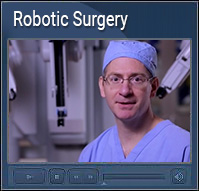Most patients leak urine immediately after surgery, however most patients regain their urinary control in time. The prostate itself serves as a dam to the flow of urine, and the external urinary sphincter muscle (which you have voluntary control over) is normally required little to help keep the urine in the bladder. Once the prostate is removed, this relatively weak muscle is called upon, all of a sudden, to perform much more work. There is an angular support issue, as well, which is disrupted upon removal of the prostate. This angular support is typically restored during the reconstructive portion of surgery. In time, as you strengthen the muscle with Kegel or pelvic floor muscle exercises, you will regain your urinary control (click for instructions on performance of Kegel exercises)
In open surgery, there is just enough working space to tack the bladder to the urethra with a few stitches and it is not intended to be perfectly watertight initially. The advent of robotic surgery has changed this. There is now a much better working space such that many more stitches may be placed between the two structures, and that junction is typically made watertight. It is possible that the extravasation of urine promotes injury to the external urinary sphincter muscle, whereas containment prevents such injury. The finer junction reconstruction seen with robotics also promotes better healing at the junction without scarification of the lumen. Additional steps have been created to restore the angular support necessary for the external urinary sphincter to function properly. This includes anterior and posterior reconstruction of the connective tissues.
The worst figures describing urinary control are found in the literature on open radical prostate surgery with only 86% of patients happily dry after a year. The best figures are found in the robotic literature with 97% of patients happily dry after a year. There are multiple other papers that demonstrate different figures for both methods. The ultimate level of urinary control may not be much different between the two methods of surgery. Part of the difficulty in distinguishing between methods is that there is a wide spectrum of what is considered successful urinary control. Strictly defined, urinary continence means no unintended urinary leakage at all, and no use of pads. Other investigators consider the use of one pad for security as an indication of success, and others are even more liberal with the definition.
The rate of return to urinary control appears to be twice as fast with the robotic method (3 months on median instead of 6 months). Again, there is variability in reports in the literature. In Dr. Kaynan’s experience, patients regain urinary control faster with the robotic method.
Typical progression of urinary control following robotic prostatectomy:
1st week postop: catheter is in the penis and urine drains to a bag. Some patients experience bladder spasms and urine may leak around the catheter. Aside from being annoying this is inconsequential.
1 week postop: a cystogram (x-ray test) is performed demonstrating no urinary leak internally and the catheter is removed on the spot. During the test, you will be coached to demonstrate restriction of the flow of urine. You will be incontinent immediately after catheter removal, however.
2nd and 3rd week postop: You will be incontinent of urine with little obvious control.
4th and 5th week postop: Most patients begin to be dry at night, and show purposeful voids during the day, though there is still little control.
6 – 12 weeks postop: There is progressive improvement in urinary control and usually a clear reduction in the number of protective pads required in a 24 hour period. By 12 weeks, about half of patients use only 1 or no pads regularly.
Progress continues steadily for most patients, and even those who considered themselves “dry” learn to fine tune their control in tricky situations such as hitting a golf ball. For those few patients who fail to demonstrate progress at a good pace, the reason is usually failure to perform Kegel exercises properly. In this instance, pelvic muscle rehabilitation (or biofeedback) is prescribed: patients visit the office weekly for several weeks to be coached with the aid of a nurse, and patch electrode which is connected to a computerized monitor for you to see.
Less than 1% of patients who undergo robotic prostatectomy remain entirely incontinent. In such cases, an artificial urinary sphincter may be implanted. For the patient with significant postoperative stress urinary incontinence, this will fix the problem. If you are intent and motivated, you are virtually guaranteed to be content with your urinary control.







